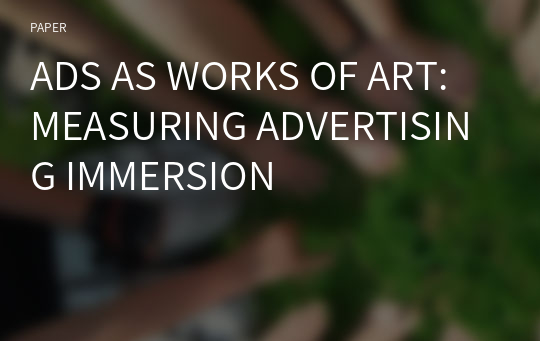ADS AS WORKS OF ART: MEASURING ADVERTISING IMMERSION
* 본 문서는 배포용으로 복사 및 편집이 불가합니다.
서지정보
ㆍ발행기관 : 글로벌지식마케팅경영학회(GFMC)
ㆍ수록지정보 : GFMC Session1
ㆍ저자명 : Jennifer Zarzosa
ㆍ저자명 : Jennifer Zarzosa
영어 초록
Advertising increasingly relies on images to persuade viewers. Some viewers engage with ads as works of art. The current research develops a valid and reliable measure of advertising immersion (AdImm). As luxury branding and art consumption often intersect, a better understanding of how AdImm affects advertising persuasion is needed.Introduction
As consumers become more visually savvy and sophisticated, it brings to light the increasing importance of visual consumption in advertising. Consumers engage with ads in different ways. Previous research focused on the product (Petty, Cacioppo, & Schumann, 1983), identity negotiation (Thompson & Haytko, 1997), or mood (Holbrook & Hirschman, 1982). Phillips and McQuarrie (2010) proposed an “engage to immerse” mode where the focus is on the image itself (i.e. aesthetic elements). The viewer undergoes an embodied experience (Joy and Sherry 2003) similar to flow (Csikszentmihalyi & Robinson, 1990) whereby the viewer processes the ad as a work of art.
While Phillips and McQuarrie (2010) provide the conceptual framework through phenomenological interviews, there is no scale to measure the advertising immersion (AdImm) construct. The research objective is to develop a valid and reliable scale.
Aesthetics in Luxury Advertising
Previous studies have examined the effects of white space (Pracejus, Olsen, & O’Guinn, 2006), prototypically (Veryzer & Hutchinson, 1998), camera angles (Meyers-Levy & Peracchio, 1992), and cropped objects (Peracchio & Meyers-Levy, 1994). While these studies follow the experimental aesthetic tradition of Berlyne (1971), they fail to examine advertising aesthetics holistically, as images depend on context and stylization to communicate, because an “experience only happens by virtue of those elements being placed together in a particular pattern of relationships to each other (Scott, 1994 pg. 270).”
Art often carries the social connotation of luxury (Scott, 1994) via art infusion (Hagtvedt & Patrick, 2008). Advertisers have appropriated art techniques, mediums, producers (Dion & Arnould, 2011), and aesthetic elements (Schroeder, 2002) to elevate the status of luxury brands in order to divorce them from their commercial orientation. Analogous to works of art, luxury brands possess an aura of high-brow authenticity. Due to the strong relationship between art and luxury consumption, it is important to measure AdImm.
Research Design & Preliminary Findings
The methodology for scale development will follow the recommendation of Churchill (1979) and Gerbing and Anderson (1988).
As a result of an extensive literature review, a set of 12 – items were generated. Expert judges were invited to examine their clarity and the extent to which they represent the construct to establish face validity. At the end of this stage, some items were rewritten or dropped while others were added. 10 items on a seven- point Likert scale anchored from strongly disagree (1) to strongly agree (7) remained (Table 1).
A convenience sample of 143 business, fashion, and art female students at a southwestern U.S. university were invited to participate in a 30 minute questionnaire. Exploratory factor analysis (EFA) was conducted to refine the AdImm scale. The maximum likelihood extraction method with promax rotation was used in EFA. Entries with missing values were deleted.
Two factors emerged from the 10 items. A total of 7 items from factor 1 emerged after items with factor loadings below 0.4 were deleted. Although item 3 cross-loaded with another factor, the cross-loading difference was greater than .2, and thus, was kept. Factor 1 explained 32.80 % of the variance. The reliability for the seven-item scale was .574, which was very low. Therefore, item 7 was deleted, which improved reliability to .832. Six items were finalized for further structural testing through confirmatory factor analysis.
Amos was used to estimate a series of confirmatory models. The method of estimation used was maximum likelihood. The initial measurement model fit poorly as evidenced by the following fit statistics: chi-square = 58.34, df = 9, CMIN/DF = 6.48; CFI = .878, GFI = .877, and RMSEA = .196.
After the initial model fit, item 4 was deleted as it had a low loadings of .45 As a result, the model fit improved. The chi-square in the revised model is 12.86 with 5 degrees of freedom. The ratio of the chi-square and degrees of freedom (CMIN/ DF) is less than 3 (2.571), which indicates an acceptable fit of the model to the data. CFI and NFI are 0.977 and 0.963, respectively. CFI and NFI are above the acceptable of .90 as suggested by Hair et al. (2006). IFI is 0.977 and GFI is 0.968, exceeding the necessary 0.95 threshold (Byrne 2010). Although the RMSEA is over the 0.08 threshold, the other fit statistics supported the model Overall, all the model statistics imply a good fit of the model. Table 2 indicates the remaining scale items and their corresponding factor loadings and critical ratio values.
Discussion
Consistent with previous research, aesthetics can serve as casual agents in shaping advertising persuasion. Because ads have a commercial orientation, viewers resist them inherently. However, advertisers can combat resistance by eliciting AdImm whereby the artfulness of the image as a whole (Joy & Sherry, 2003) rather than some stylistic property triggers an intense brand experience; similar to viewers of art at a gallery or museum.
As a route of persuasion, AdImm intensifies brand experience rather than boosting brand evaluation (Phillips & McQuarrie, 2010). Previous research has examined the relationship between brand experience and brand attitude as well as purchase intention (Zarantonello & Schmitt, 2010). Future research will assess predictive validity to determine how AdImm influences advertising persuasion. Since luxury branding and art consumption intersect, luxury advertisers will better understand how AdImm affects advertising persuasion. Additionally, the valid and reliable AdImm scale will provide the opportunity for scholars to study aesthetics from an interdisciplinary perspective.
참고 자료
없음"GFMC Session1"의 다른 논문
 FAST AND SLOW FASHION BRANDS IN DEVELOPING SUSTAINABLE ..6페이지
FAST AND SLOW FASHION BRANDS IN DEVELOPING SUSTAINABLE ..6페이지 “WHAT IF A CELEBRITY AND A BRAND CO-CREATE A NEW COLLEC..7페이지
“WHAT IF A CELEBRITY AND A BRAND CO-CREATE A NEW COLLEC..7페이지 THE INSTAGRAM’S STRATEGY IN ENGAGING THE CUSTOMER’S LOY..3페이지
THE INSTAGRAM’S STRATEGY IN ENGAGING THE CUSTOMER’S LOY..3페이지 THE PARTICULARITIES OF NEW PRODUCT DEVELOPMENT IN THE T..5페이지
THE PARTICULARITIES OF NEW PRODUCT DEVELOPMENT IN THE T..5페이지 THE LONE CHOCOLATE BAR: THE INFLUENCE OF PERCEIVED SCAR..6페이지
THE LONE CHOCOLATE BAR: THE INFLUENCE OF PERCEIVED SCAR..6페이지 ECONOMIES OF SMALL: NICHE STRATEGIES AND SUCCESS FACTOR..8페이지
ECONOMIES OF SMALL: NICHE STRATEGIES AND SUCCESS FACTOR..8페이지 THE INFLUENCE OF ONLINE CUSTOMER REVIEWS ON RETAILERS' ..6페이지
THE INFLUENCE OF ONLINE CUSTOMER REVIEWS ON RETAILERS' ..6페이지 IS THE ARTIFICATION PROCESS PERCEIVED BY FINAL CONSUMER..6페이지
IS THE ARTIFICATION PROCESS PERCEIVED BY FINAL CONSUMER..6페이지 THE ODD EVEN PRICE PARADOX IN THE FASHION LUXURY SECTOR6페이지
THE ODD EVEN PRICE PARADOX IN THE FASHION LUXURY SECTOR6페이지 CONCEPTUALISING BEAUTY IN CONSUMER RESEARCH: A FRAMEWOR..8페이지
CONCEPTUALISING BEAUTY IN CONSUMER RESEARCH: A FRAMEWOR..8페이지


























